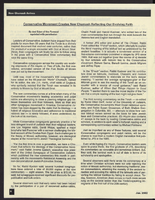Search the Special Collections and Archives Portal
Search Results
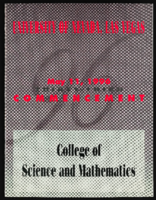
University of Nevada, Las Vegas (UNLV) College of Science and Mathematics 33rd commencement program
Date
Archival Collection
Description
Commencement program from University of Nevada, Las Vegas Commencement Programs and Graduation Lists (UA-00115).
Text
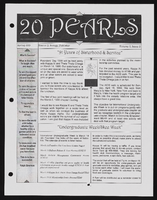
Alpha Kappa Alpha Sorority, Theta Theta Omega Chapter "20 Pearls" newsletter
Date
Archival Collection
Description
From the Alpha Kappa Alpha Sorority, Incorporated, Theta Theta Omega Chapter Records (MS-01014) -- Chapter records file.
Text
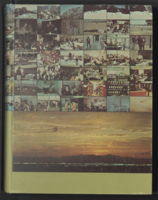
Epilogue: UNLV Yearbook, 1970
Date
Description
Yearbook main highlights: schools and departments; detailed lists with names and headshots of faculty, administration and students; variety of photos from activities, festivals, campus life, and buildings; campus organizations such as sororities, fraternities and councils; beauty contest winners; college sports and featured athletes; and printed advertisements of local businesses; Institution name: University of Nevada, Las Vegas
Mixed Content

Transcript of interview with Robert D. Howell by Joe Sant, February 26, 1977
Date
Archival Collection
Description
On February 26, 1977, collector Joe Sant interviewed local Nevadan business owner, Robert D. Howell (born November 22nd, 1939 in Las Vegas, Nevada) in his home in Las Vegas, Nevada. This interview covers Las Vegas in the old days, from Mr. Howell’s personal experience of being born and raised in Nevada. During this interview, Mr. Howell also discusses the early above ground atomic tests, local environmental and social changes, the economic landscape, the Mormon Fort, religious beliefs, and local recreation. The interview concludes with discussion on air pollution.
Text
Elton and Madelaine Garrett Photograph and Architectural Drawing Collection
Identifier
Abstract
The Elton and Madelaine Garrett Photograph and Architectural Drawing Collection contains photographic prints and architectural drawings of Boulder (Hoover) Dam; Las Vegas, Nevada; Boulder City, Nevada; and other locations in the American Southwest from approximately 1927 to 1990. The photographs primarily depict Hoover Dam's construction and areas around Hoover Dam, Las Vegas, and Boulder City during the 1930s and 1940s. The bulk of the architectural drawings and maps are projects and diagrams related to the planning and development of Boulder City, Nevada between 1943 and 1985.
Archival Collection

Transcript of interview with Lawrence Canarelli by Claytee White, May 1, 2016
Date
Archival Collection
Description
“At five years old, I was the youngest boy at the orphanage. This was the first time that I had lived with indoor plumbing and indoor showers.” To describe award-winning home builder Larry Canarelli as a self-made man is to grossly understate his accomplishments and his determination. Canarelli, founder of American West, Nevada’s largest privately owned development company, learned all about living without shelter as a very young boy. When he was nine years old, Canarelli, the second of his mother’s six children, encouraged his veteran stepfather to buy the family’s first permanent house for $80 down and an agreement to assume payments on the Veterans Administration loan. As his school peers dreamt of large, shiny cars, Canarelli envisaged big, beautiful houses. After self-funding his education, graduating from the University of California Los Angeles, completing two years of U.S. Army service, and earning his Master’s degree from University of Southern California, Canarelli began his career working with a large home building firm in the Los Angeles area. Three years later he switched firms, and the new company sent him to Las Vegas. In this interview, Canarelli reaches back to his childhood to explain his motivation to build houses: “All of my life, I had an interest in housing. Perhaps this is because of never having a house when I was younger.” He recalls how the Collins Brothers helped him when he founded American West. He describes the Southern Nevada “shelter market” of the 1970s and follows its evolution in style and marketing through the 1980s and 1990s; he talks about master planning and the builders who first master planned their Clark County developments: Pardee Homes in Spring Valley, American Nevada in Green Valley, and Howard Hughes Corporation in Summerlin. He speaks to the influences of interest rates and available land on housing prices; the importance of environmentally responsible housing; where the entry-level housing market will go, and ways that technology has changed home building and home buying. And throughout, he exemplifies his devotion to, knowledge of, and respect for Southern Nevada’s housing industry-its builders, its market, and its buyers.
Text
Audio clip of an inteview with Chris Ramirez by Wendy Starkweather on October 2, 2013.
Date
Archival Collection
Description
Sound
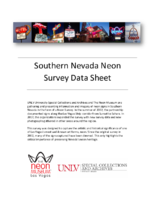
4 Mile Bar Neon Survey document, September 8, 2017
Date
Archival Collection
Description
Site name: 4 Mile Bar (Las Vegas, Nev.)
Site address: 3650 Boulder Hwy
Sign owner: Bob and Bill Joslin
Sign details: This is one of the most historic bars in Las Vegas. The original site of the bar was actually where one of the oldest communities in town began called Formyle. The community was there long before The Boulder Highway or US Highway 95. The area where the bar currently resides was called Four Mile Spring because it was "four miles from the center of town" and for the natural spring that was there. This part of town, for much of its history, was outside of Las Vegas city limits and outside of the laws for the rest of the city as well. This site was originally a brothel when it opened in the 1950s. In 1954, the property was raided by the FBI and then ended up turning into a bar. It is "one of the Valley's last true-blue roadhouses" and it is named because it sits four miles away from the Downtown area. They are also known for their very popular karaoke nights.
Sign condition: 4, the roadside sign is in good condition, but the sign that is attached to the building has some light bulbs that have been burned out on it.
Sign form: Roadside sign is a pole sign with a message center and there is an architectural sign attached to the facade of the building.
Sign-specific description: The road side portion of the signage for the 4 Mile Bar is fairly simple. The top of the sign features a plastic, backlit square that has a large red "4" and "MILE" in bold white text in the middle of the number. Underneath this is "BAR" in a bold red text against a white background. About a foot or two underneath this sign is a large plastic, backlit reader board. The main support for the sign is a white rectangular structure with two red stripes running down the center of it with a few inches of space between the lines. The architectural sign that is on the facade of the building is uncomplicated as well. The shape of it fits the top portion of the building and looks like a stretched out rectangle. All of the edges are lined by incandescent light bulbs. In the middle of the sign in open channel letters are the words "4 MILE BAR" that are filled with white glowing neon tubes.
Sign - type of display: Incandescent, neon and backlit plastic portion
Sign - media: Steel and plastic
Sign - non-neon treatments: Plastic
Sign environment: This bar sits at the cusp where Fremont Street transitions to Boulder Highway. Many of the immediate properties that sit near this bar are motels and mobile home communities. This is also just down the road from Boulder Station Hotel and Casino as well as the Winchester Cultural Center.
Sign - thematic influences: The roadside sign is very straightforward since it just displays the name of the bar, but there could have been a stylistic choice to use the actual number "4" instead of the word "four."
Sign - artistic significance: The most notable feature about this sign is the number "4" instead of the word "four" that is used, possibly for stylistic reasons.
Survey - research locations: Accessor's Page http://www.clarkcountynv.gov/assessor/Pages/searchbybusinessname.aspx, Review Journal articles https://storify.com/ReviewJournal/7-of-the-most-historic-bars-in-las-vegas and https://www.reviewjournal.com/uncategorized/over-a-century-four-mile-has-gone-from-trailside-oasis-to-brothel-to-bar/ , Vegas Seven article http://vegasseven.com/2013/06/12/las-vegas-bar-hall-fame/
Surveyor: Lauren Vaccaro
Survey - date completed: 2017-09-08
Sign keywords: Architectural; Incandescent; Neon; Backlit; Plastic; Steel; Pole sign; Roadside
Text

Transcript of interview with Betsy Fretwell by Claytee White and Stefani Evans, August 30, 2016
Date
Archival Collection
Description
Shortly before the University of Georgia granted Betsy Fretwell Master's degree in public administration in 1991, she applied for a one-year internship with Clark County, Nevada. The County hired her, but Fretwell did not complete her internship. Instead, the County promoted her, hired her full-time, and soon had her lobbying for the County's interests in Carson City. Her insistence on learning all sides of a question and communicating that knowledge to the decision makers was one of the skills that made her so valuable to Clark County administrators. In this interview, Fretwell discusses her South Carolina childhood, her affinity for the University of Georgia Bulldogs, and the path she took to occupy the office of city manager for the City of Las Vegas. She talks about her years at Clark County and a term at the City of Henderson, but she mostly focuses on her sixteen years at the City of Las Vegas, first as assistant city manager under Virginia Valentine and later as city manage
Text

